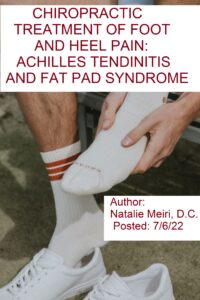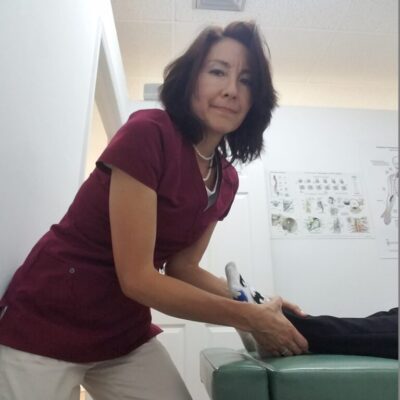
From Dr. Natalie Meiri’s Clinical Pearl Stories:
CHIROPRACTIC TREATMENT OF FOOT AND HEEL PAIN:
ACHILLES TENDINITIS AND FAT PAD SYNDROME
This was a 58 year old patient who had a chief complaint of right achilles tendon and heel pain. To be HIPAA compliant, I will call her Roberta instead of her real name. Roberta was an avid hiker for over 30 years. She hiked often uphill and on uneven terrain that put added strain on both her feet and ankles. Roberta also enjoyed long walks barefoot on the beach. Unfortunately, this chronic pain never quite seemed to go away and was keeping her from her activities. She truly wanted to get back to doing her activities pain free.
Roberta’s History
Roberta presented to my office complaining of pain in the middle of her right heel (back part of foot behind the arch and below the ankle) and achilles tendon (thick tendon located in the back of the leg). She had ankle and foot pain on and off for years. The repetitive hiking activities had caused her a lot of different ankle/foot problems which included: achilles tendinitis and plantar fasciitis. Roberta had been seeing a podiatrist who gave her a “night boot”, orthotics and stretches. But she didn’t want cortisone injections and wanted to avoid surgery. Similarly, she purchased better shoes for hiking and modified her hiking activities to give her injuries a chance to heal.
Now, she no longer had plantar fasciitis in her feet. Moreover, some improvement had been made for her heel pain and achilles tendinitis until recently when she walked and swam barefoot on the beach/ocean. So when she visited her podiatrist for treatment, he informed her she wouldn’t be able to walk on the beach barefoot anymore. Finally, she was taking over the counter drugs such as acetaminophen (for pain) and a NSAID (Non-steroidal anti-inflammatory drug for inflammation) which seemed to help very little. After this, she came to see me.

Roberta’s Examination and Diagnoses
Roberta had pain at the right achilles tendon and the middle of her right heel upon palpation (pressing on area by doctor). She had this pain while walking or just standing/weight bearing. She knew this was a repetitive injury from her hiking. Nevertheless, “jumping into the waves” barefoot at the beach might have exacerbated it recently. Upon examination, there were positive tests for the right achilles pain for achilles tendonitis. Furthermore, she had positive tests for Fat Pad Syndrome for her heel pain.
Roberta’s Imaging/X-rays
After the exam, I took some x-rays of her right foot. Findings on her x-rays were osteoarthritis, a degenerative “wear-and-tear” type of arthritis in her right ankle and foot. In fact, she had heel spurs on her x-rays. She had one at the back of the heel and bottom of the foot. A M.R.I. (magnetic resonance image) of her right foot would be ordered if there was no improvement within 12 visits.
Bone Spurs on Roberta’s X-rays
The main cause of bone spurs (bony projections) are the damage associated with osteoarthritis. Bone spurs can develop on almost any bone, including the heel. Achilles tendinitis can be associated with dorsal (back of the heel) bone spurs as seen on Roberta’s x-ray. The spur is where the Achilles tendon inserts into the bone. Roberta’s achilles tendon was inflamed and she had achilles tendinitis. It was part of her chief complaint along with her heel pain which I diagnosed as fat pad syndrome.
Cause of Achilles Tendonitis
Firstly, the Achilles tendon is covered by a peritenon (connective tissue sheath surrounding a tendon) composed of mainly areolar tissue (fatty tissue) which functions as a cushion. The area most affected in tendinitis is approximately 2 cm proximal (close) to the calcaneal insertion (heel attachment). The demands on the tendon are high in running and jumping sports.
Secondly, at the heel insertion (attachment site) there can be a complicating problem. The retrocalcaneal bursa (small cushioning sac between the heel bone and the achilles tendon) can get irritated. Eventually, this may lead to a Haglund’s deformity (bony enlargement found on the back of the heel).
Thirdly, if you have an inflammatory arthritis due to reiter’s syndrome or ankylosing spondylitis which are systemic diseases (affecting entire body), it can cause what’s called an enthesopathy. Enthesopathy is a disorder of the entheses. The “enthesis” is the area where the tendon, ligament, or joint capsule inserts into bone.
Fourthly, in athletic children, pain and tenderness at the calcaneus (heel bone) may indicate sever’s disease/apophysitis. Sever’s disease is a painful condition of the heel that occurs in growing children. It happens when the tendon that attaches to the back of the heel (the Achilles tendon) pulls on the growth plate (the apophysis) of the bone of the heel (the calcaneus).
In summary, in Roberta’s case, she injured her achilles tendon through repetitive injury (e.g. hiking) and jumping in the waves in the ocean/beach.
Cause of Fat Pad Syndrome
Firstly, the heel fat pad is a specialized soft tissue structure formed of adipose (fat) tissue that overlies the inferior (bottom) and posterior (back) aspect of the calcaneus (heel bone). It provides the cushioning effect of the heel. It can be a cause of debilitating heel pain. Secondly, as a person ages, this fat pad degenerates, leaving little shock absorption for the calcaneus (heel bone). Finally, shoes that do not have firm heel counters and/or are too wide allow the remaining fat pad to flatten out. This can decrease the thickness and therefore shock absorption. Both support of the remaining fat pad and use of various heel cups may be helpful. The heel cup is often made of shock-absorbent material and provides some support. Some people do better with a more rigid support in the heel counter of the shoe to prevent more spreading/flattening out of the fat pad.


Roberta’s Chiropractic Treatment for Achilles Tendinitis and Fat Pad Syndrome
Roberta’s treatments included chiropractic adjustments/ manipulation to her right foot, ankle and any associated lower extremity (leg/limb), pelvic or lumbar (low back) fixations (chiropractic misalignments). Additionally, soft tissue therapy (myofascial release, pressure point and various post isometric relaxation procedures) and modalities (cold/heat therapy and electric muscle stimulation) were administered. Finally, she was given homeopathic medicines and therapeutic exercises to continue her treatment at home.
Roberta gradually got pain relief and improved function in her activities. It took a few months of treatment before she was performing her activities pain free. Roberta was able to hike and walk barefoot on the beach pain-free. Chiropractic proved to be highly effective!
At Meiri Chiropractic we spend the time necessary to examine, diagnose and treat every neuromusculoskeletal condition and various ailments you have. Chiropractic is a holistic and natural way to not only treat existing conditions, but to keep your body in its best working condition. We have been offering effective chiropractic care in Palm Beach county since 2006. Many of our patient reviews note our excellence. Call us today at 561-253-8984 to make an appointment or to find out more about Chiropractic Treatment of Foot and Heel Pain: Achilles Tendinitis and Fat Pad Syndrome.
Meiri Chiropractic
561-253-8984